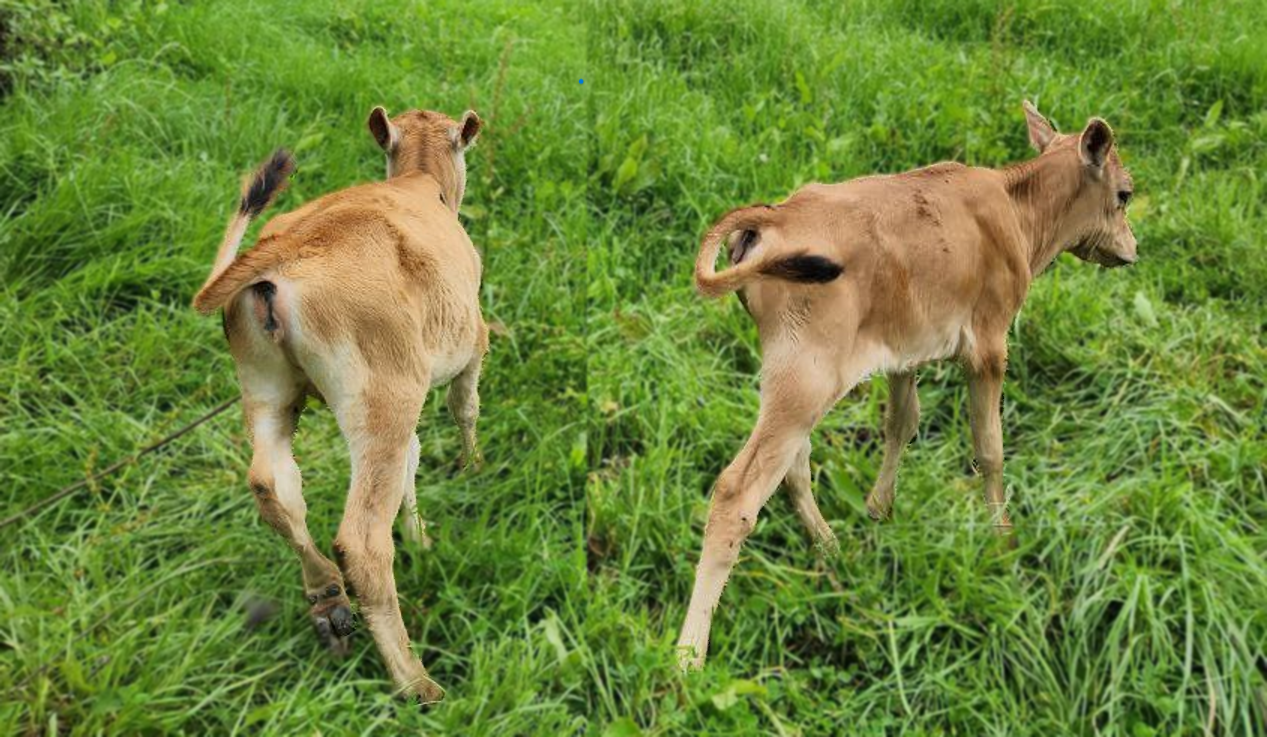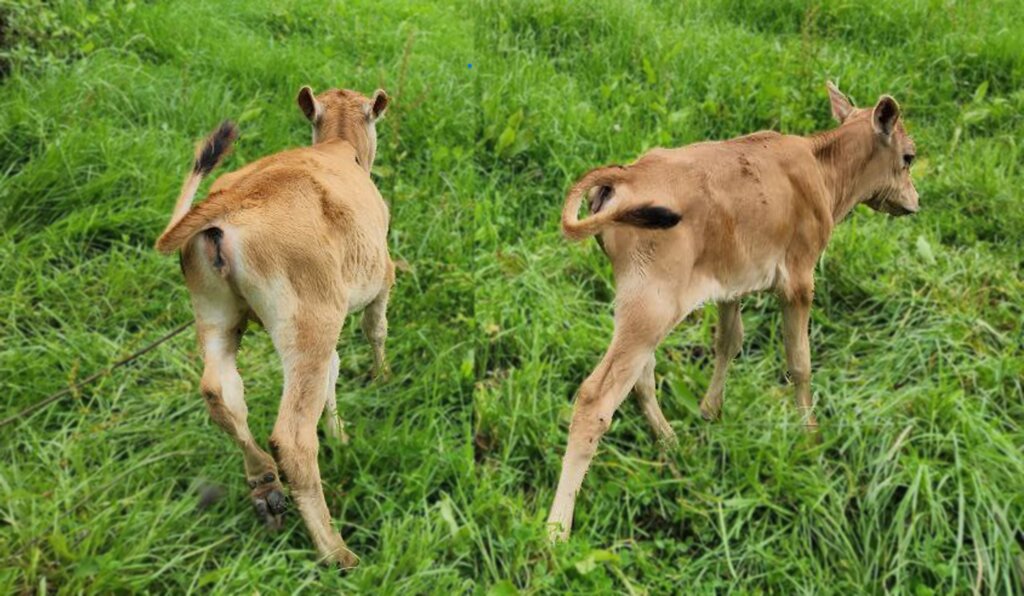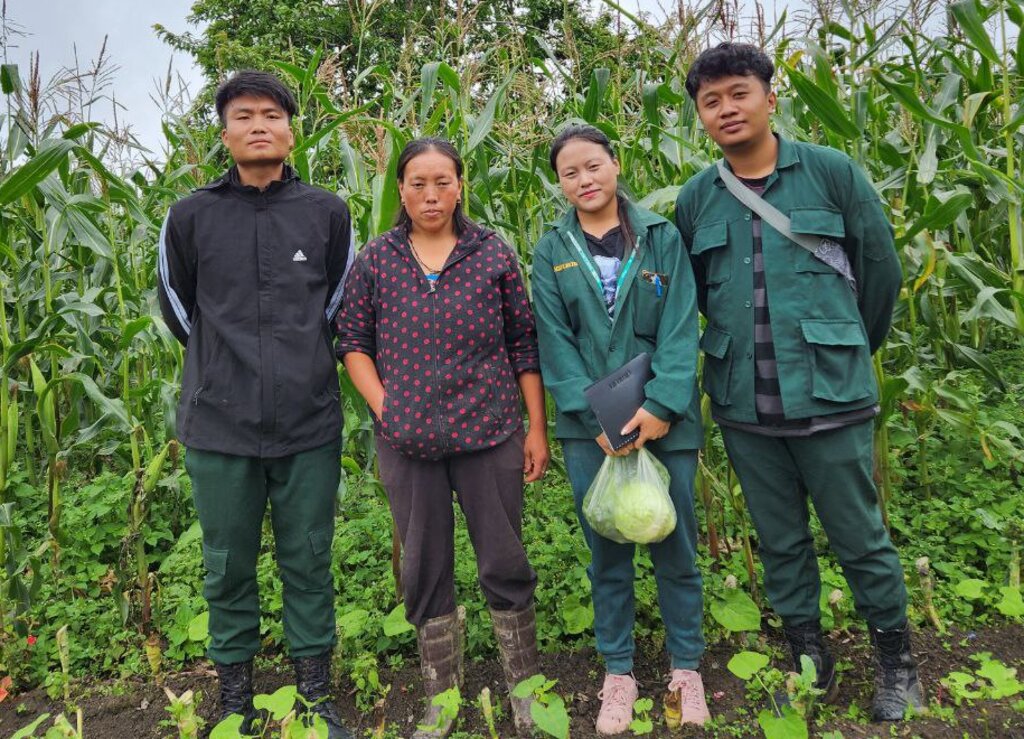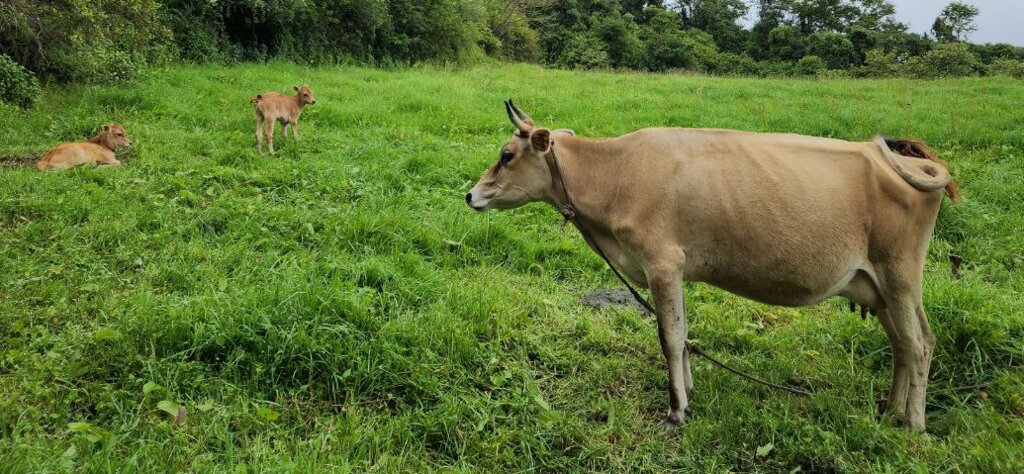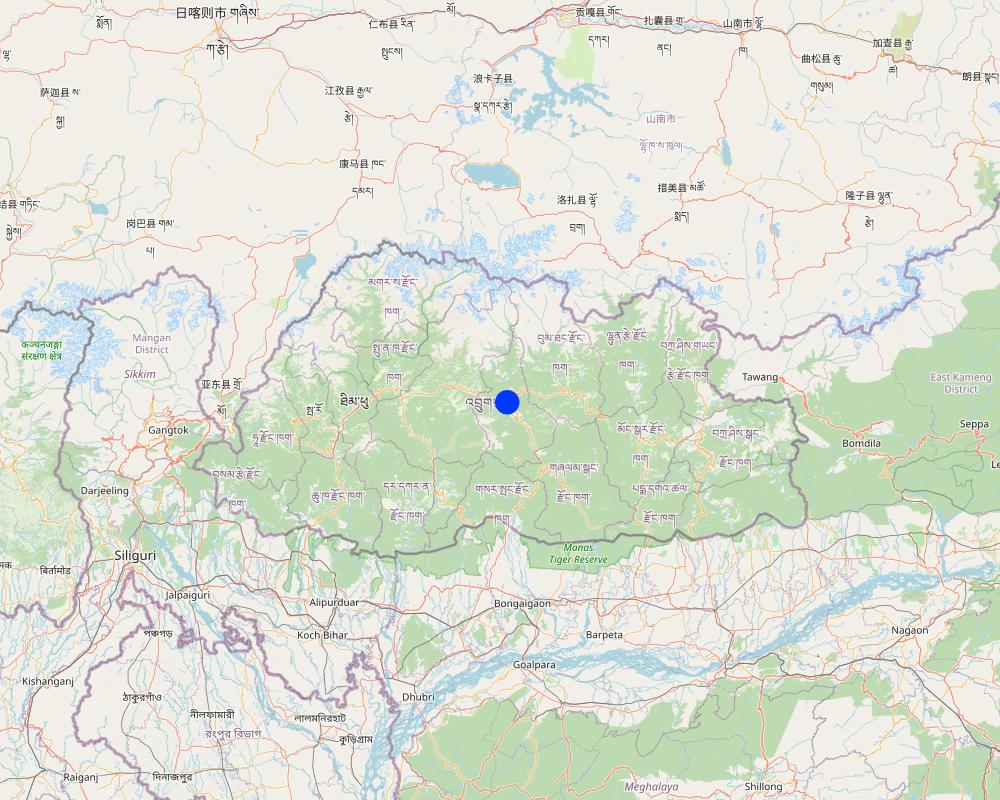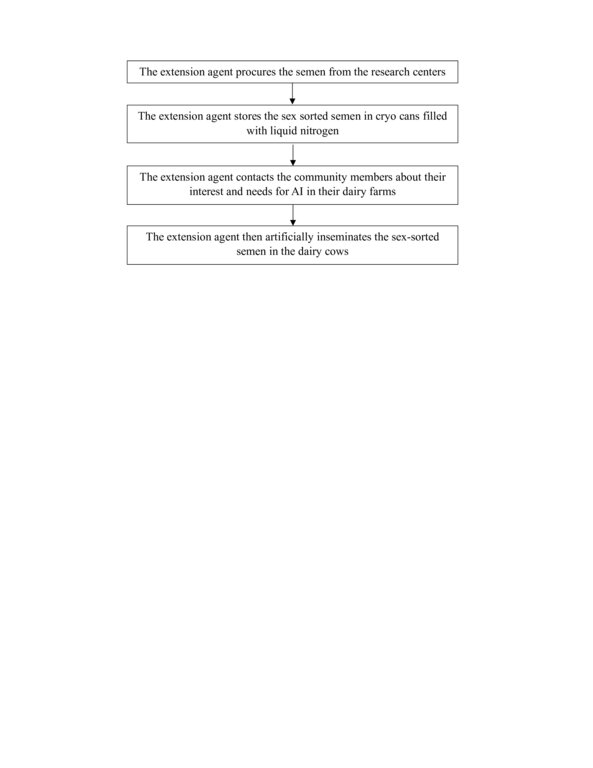Sexed semen technology [ภูฏาน]
- ผู้สร้างสรรค์:
- การอัพเดท:
- ผู้รวบรวม: ONGPO LEPCHA
- ผู้เรียบเรียง: Kuenzang Nima
- ผู้ตรวจสอบ: William Critchley, Rima Mekdaschi Studer
Pho mo akha chi yaedpai khab saen gi thrilrig
technologies_6823 - ภูฏาน
ดูส่วนย่อย
ขยายทั้งหมด ย่อทั้งหมด1. ข้อมูลทั่วไป
1.2 รายละเอียดที่ติดต่อได้ของผู้รวบรวมและองค์กรที่เกี่ยวข้องในการประเมินและการจัดเตรียมทำเอกสารของเทคโนโลยี
วิทยากรหลัก
ผู้ใช้ที่ดิน:
Pem Tenzin
Tshangkha village
ภูฏาน
ชื่อของโครงการซึ่งอำนวยความสะดวกในการทำเอกสารหรือการประเมินเทคโนโลยี (ถ้าเกี่ยวข้อง)
Strengthening national-level institutional and professional capacities of country Parties towards enhanced UNCCD monitoring and reporting – GEF 7 EA Umbrella II (GEF 7 UNCCD Enabling Activities_Umbrella II)ชื่อขององค์กรซึ่งอำนวยความสะดวกในการทำเอกสารหรือการประเมินเทคโนโลยี (ถ้าเกี่ยวข้อง)
National Soil Services Centre, Department of Agriculture, Ministry of Agriculture & Livestock (NSSC) - ภูฏาน1.3 เงื่อนไขการใช้ข้อมูลที่ได้บันทึกผ่านทาง WOCAT
ผู้รวบรวมและวิทยากรหลักยอมรับเงื่อนไขเกี่ยวกับการใช้ข้อมูลที่ถูกบันทึกผ่านทาง WOCAT:
ใช่
1.4 การเปิดเผยเรื่องความยั่งยืนของเทคโนโลยีที่ได้อธิบายไว้
เทคโนโลยีที่ได้อธิบายไว้นี้เป็นปัญหาของความเสื่อมโทรมโทรมของที่ดินหรือไม่ จึงไม่ได้รับการยอมรับว่าเป็นเทคโนโลยีเพื่อการจัดการที่ดินอย่างยั่งยืน:
ไม่ใช่
แสดงความคิดเห็น:
The technology is not directly related to land degradation. However, it contribute to sustainable land management practices, as adoption of sexed semen technology pre-determines sex of calf in favor of female progeny (about 90% female and 10% male) that demands good management practices such as development of improved pasture, and improved dairy sheds.
2. การอธิบายลักษณะของเทคโนโลยี SLM
2.1 การอธิบายแบบสั้น ๆ ของเทคโนโลยี
คำจำกัดความของเทคโนโลยี:
Sexed semen technology produces gender-selected semen for artificially insemination of dairy cows. It ensures a higher proportion of female calves (more than 90%) which will ultimately contribute to the enhancement of milk production in the herd.
2.2 การอธิบายแบบละเอียดของเทคโนโลยี
คำอธิบาย:
The Artificial Insemination (AI) program, initiated in 1987, has helped AI evolve into a widespread practice for dairy farms across Bhutan, with increasing accessibility due to improved road and transportation networks. The surge in demand for dairy products has positioned AI technology as key in transforming dairy farms from subsistence to market-oriented production systems.
A recent addition to the programme is the use of sexed semen, meaning sorting of semen before artificial insemination. Semen sorting involves categorizing bull semen based on the X and Y chromosomes, thus granting dairy land users control over calf gender. This empowers them to engage in selective breeding, enhancing desired traits and overall quality of dairy production.
Several key activities are integral to this technology:
•Rigorous selection of bulls with desirable traits related to milk production and overall health.
•Collection and preservation of semen from selected bulls.
•Semen sorting technology to separate X and Y chromosome-bearing sperm.
•Artificial insemination of dairy cows by extension agents who use sorted semen.
The benefits are multiple because achieving a higher proportion of heifer calves helps dairy land users to enhance breeding strategies and maintain desired traits within the herd. Economic benefits follow through increased dairy production and improved cattle health.
Land users express satisfaction with the technology and its impact. However, some households report problems with conception rates after AI with sexed semen. Despite these drawbacks, the overall benefits to dairy land users and the industry outweigh the limitations.
2.3 รูปภาพของเทคโนโลยี
2.5 ประเทศภูมิภาค หรือสถานที่ตั้งที่เทคโนโลยีได้นำไปใช้และได้รับการครอบคลุมโดยการประเมินนี้
ประเทศ:
ภูฏาน
ภูมิภาค/รัฐ/จังหวัด:
Trongsa
ข้อมูลจำเพาะเพิ่มเติมของสถานที่ตั้ง :
Tshangkha, Tangsibji
ระบุการกระจายตัวของเทคโนโลยี:
- ใช้ ณ จุดที่เฉพาะเจาะจงหรือเน้นไปยังบริเวณพื้นที่ขนาดเล็ก
Is/are the technology site(s) located in a permanently protected area?
ไม่ใช่
Map
×2.6 วันที่การดำเนินการ
ถ้าไม่รู้ปีที่แน่นอน ให้ระบุวันที่โดยประมาณ:
- 10-50 ปี
2.7 คำแนะนำของเทคโนโลยี
ให้ระบุว่าเทคโนโลยีถูกแนะนำเข้ามาอย่างไร:
- ทางโครงการหรือจากภายนอก
ความคิดเห็น (ประเภทของโครงการ เป็นต้น) :
The technology was introduced by the Department of Livestock to increase the likelihood of birthing female cattle and enhance milk production across the country.
3. การจัดประเภทของเทคโนโลยี SLM
3.1 วัตถุประสงค์หลักของเทคโนโลยี
- ปรับปรุงการผลิตให้ดีขึ้น
- ลด ป้องกัน ฟื้นฟู การเสื่อมโทรมของที่ดิน
- รักษาสภาพหรือปรับปรุงความหลากหลายทางชีวภาพ
- สร้างผลกระทบทางด้านเศรษฐกิจที่เป็นประโยชน์
- Improves dairy production
3.2 ประเภทของการใช้ที่ดินในปัจจุบันที่ได้นำเทคโนโลยีไปใช้
Land use mixed within the same land unit:
ไม่ใช่

พื้นที่ปลูกพืช
- การปลูกพืชล้มลุกอายุปีเดียว
Annual cropping - Specify crops:
- cereals - maize
- cereals - wheat (spring)
- root/tuber crops - potatoes
- vegetables - leafy vegetables (salads, cabbage, spinach, other)
- vegetables - root vegetables (carrots, onions, beet, other)
จำนวนของฤดูเพาะปลูกต่อปี:
- 1
Is intercropping practiced?
ไม่ใช่
Is crop rotation practiced?
ใช่
ถ้าใช่ ระบุ:
The crop rotation is normally done with the crops listed above, after the growing season of each crops.

ทุ่งหญ้าเลี้ยงสัตว์
ทุ่งหญ้าเลี้ยงสัตว์ที่มีการจัดการแบบเข้มข้นหรือการผลิตอาหารสัตว์:
- ตัดแล้วขนไป / ไม่มีการปล่อยแทะเล็มเอง (Cut-and-carry / zero grazing)
- ทุ่งหญ้าเลี้ยงสัตว์ที่ได้มีการปรับปรุง (Improved pastures)
Animal type:
- cattle - dairy
แสดงความคิดเห็น:
The land is where the manure of the dairy cattles are applied on.
3.3 Has land use changed due to the implementation of the Technology?
Has land use changed due to the implementation of the Technology?
- No (Continue with question 3.4)
3.4 การใช้น้ำ
การใช้น้ำของที่ดินที่มีการใช้เทคโนโลยีอยู่:
- น้ำฝนร่วมกับการชลประทาน
แสดงความคิดเห็น:
The irrigation is mostly rainfed; however, the availability of water in the community is not an issue.
3.5 กลุ่ม SLM ที่ตรงกับเทคโนโลยีนี้
- การจัดการปลูกพืชร่วมกับปศุสัตว์
- การปรับปรุงพันธุ์พืชหรือพันธุ์สัตว์ต่าง ๆ
3.6 มาตรการ SLM ที่ประกอบกันเป็นเทคโนโลยี

มาตรการจัดการพืช
- A1: พืช/สิ่งปกคลุมดิน
- A2: อินทรียวัตถุในดิน/ความอุดมสมบูรณ์ในดิน
3.7 รูปแบบหลักของการเสื่อมโทรมของที่ดินที่ได้รับการแก้ไขโดยเทคโนโลยี

การเสื่อมโทรมของดินทางด้านชีวภาพ
- Bc (Reduction of vegetation cover): การลดลงของจำนวนพืชที่ปกคลุมดิน
- Bl (Loss of soil life): การสูญเสียสิ่งมีชีวิตในดิน

อื่น ๆ
ระบุ:
There is very minimal land degradation.
แสดงความคิดเห็น:
The technology was implemented to address dairy production however, it also contributed to reduced land degradation because many land users have opted for improved dairy cattle by replacing local breeds which were numerous and unproductive.
3.8 การป้องกัน การลดลง หรือการฟื้นฟูความเสื่อมโทรมของที่ดิน
ระบุเป้าหมายของเทคโนโลยีกับความเสื่อมโทรมของที่ดิน:
- ไม่สามารถใช้ได้
แสดงความคิดเห็น:
This technology is aimed to improve genetic of cattle breed to enhanced dairy production and reduce unproductive cattle population. However, the technology has indirect benefits on sustainable land management through the application of manures, improved housing and pasture development
4. ข้อมูลจำเพาะด้านเทคนิค กิจกรรมการนำไปปฏิบัติใช้ ปัจจัยนำเข้า และค่าใช้จ่าย
4.1 แบบแปลนทางเทคนิคของเทคโนโลยี
ข้อมูลจำเพาะด้านเทคนิค (แบบแปลนทางเทคนิคของเทคโนโลยี):
Since sexed semen technology was not directly established in the community members, the product of the technology was used in the field through AI. Therefore, a flow chart of how the technology is implemented in the field was not created
ผู้เขียน:
Palden Wangchuk Dorji
วันที่:
07/07/2023
4.2 ข้อมูลทั่วไปเกี่ยวกับการคำนวณปัจจัยนำเข้าและค่าใช้จ่าย
ให้ระบุว่าค่าใช้จ่ายและปัจจัยนำเข้าได้รับการคำนวณอย่างไร:
- ต่อหน่วยเทคโนโลยี
โปรดระบุหน่วย:
Number
Specify dimensions of unit (if relevant):
AI straw
อื่นๆ หรือสกุลเงินประจำชาติ (ระบุ):
Ngultrum
If relevant, indicate exchange rate from USD to local currency (e.g. 1 USD = 79.9 Brazilian Real): 1 USD =:
79.62
ระบุค่าเฉลี่ยของค่าจ้างในการจ้างแรงงานต่อวัน:
600
4.3 กิจกรรมเพื่อการจัดตั้ง
| กิจกรรม | Timing (season) | |
|---|---|---|
| 1. | Procurement of sexed semen | Based on indent or the annual requirement at National level |
| 2. | Storage of sexed semen | After procurement until distributed to dzongkhags at Central level |
| 3. | Transportation and Distribution of sexed semen | As per schedule, every 45 days |
| 4. | Storage of semen | semen bank at Veterinary Hospital and AI centre on regular basis |
| 5. | Render Artificial insemination services to farmers by AI technician | Based on request of farmers reporting on animal showing heat signs |
| 6. | Follow up on AI services (monitoring) | 18-22 days, repeat case, monthly report, ad hoc through phone call |
4.4 ค่าใช้จ่ายของปัจจัยนำเข้าที่จำเป็นสำหรับการจัดตั้ง
| ปัจจัยนำเข้า | หน่วย | ปริมาณ | ค่าใช้จ่ายต่อหน่วย | ค่าใช้จ่ายทั้งหมดต่อปัจจัยนำเข้า | %ของค่าใช้จ่ายที่ก่อให้เกิดขึ้นโดยผู้ใช้ที่ดิน | |
|---|---|---|---|---|---|---|
| แรงงาน | Community AI Technician | person/Day | 2.0 | 1000.0 | 2000.0 | |
| อุปกรณ์ | Sexed semen AI | per straw | 1.0 | 1500.0 | 1500.0 | |
| อุปกรณ์ | golves | No | 1.0 | 5.0 | 5.0 | |
| อุปกรณ์ | AI sheath | No | 1.0 | 16.0 | 16.0 | |
| อุปกรณ์ | LN2 | litre | 300.0 | 35.0 | 10500.0 | |
| อุปกรณ์ | LN2 container (55 litre) | No | 2.0 | 25050.0 | 50100.0 | |
| อุปกรณ์ | Portable AI container (5 litres) | No | 1.0 | 11200.0 | 11200.0 | |
| อุปกรณ์ | Water boiler (3 litres) | No | 1.0 | 2800.0 | 2800.0 | |
| อุปกรณ์ | Jug | No | 1.0 | 30.0 | 30.0 | |
| วัสดุด้านพืช | Funnel | No | 1.0 | 150.0 | 150.0 | |
| วัสดุด้านพืช | Towel | No | 1.0 | 100.0 | 100.0 | |
| วัสดุด้านพืช | Flexible Dip stick | No | 1.0 | 2500.0 | 2500.0 | |
| วัสดุสำหรับก่อสร้าง | AI crates | No | 1.0 | 45000.0 | 45000.0 | |
| อื่น ๆ | Travel | km | 15.0 | 30.0 | 450.0 | |
| ค่าใช้จ่ายทั้งหมดของการจัดตั้งเทคโนโลยี | 126351.0 | |||||
| Total costs for establishment of the Technology in USD | 1586.93 | |||||
ถ้าผู้ใช้ที่ดินรับภาระน้อยกว่า 100% ของค่าใช้จ่าย ให้ระบุว่าใครเป็นผู้รับผิดชอบส่วนที่เหลือ:
The cost is normally covered by the Royal Government of Bhutan
แสดงความคิดเห็น:
The cost is based on conducting AI for a single dairy cow
4.5 การบำรุงรักษาสภาพหรือกิจกรรมที่เกิดขึ้นเป็นประจำ
| กิจกรรม | ช่วงระยะเวลา/ความถี่ | |
|---|---|---|
| 1. | Storage of the sex sorted semen | When the semen is procured by the extension agent and before conducting AI |
4.6 ค่าใช้จ่ายของปัจจัยนำเข้าและกิจกรรมที่เกิดขึ้นเป็นประจำที่ต้องการการบำรุงรักษา (ต่อปี)
ถ้าผู้ใช้ที่ดินรับภาระน้อยกว่า 100% ของค่าใช้จ่าย ให้ระบุว่าใครเป็นผู้รับผิดชอบส่วนที่เหลือ:
The cost is mostly covered by the Royal Government of Bhutan
แสดงความคิดเห็น:
The only maintenance regarding this technology is the storage of the AI straw filled with sex-sorted semen in cryocan filled with liquid nitrogen. The cost is also based on a single AI straw.
4.7 ปัจจัยสำคัญที่สุดที่มีผลกระทบต่อค่าใช้จ่าย
ปัจจัยสำคัญที่สุดที่มีผลกระทบต่อค่าใช้จ่ายต่างๆ:
Material cost, heat detection, distance
5. สิ่งแวดล้อมทางธรรมชาติและของมนุษย์
5.1 ภูมิอากาศ
ฝนประจำปี
- < 250 ม.ม.
- 251-500 ม.ม.
- 501-750 ม.ม.
- 751-1,000 ม.ม.
- 1,001-1,500 ม.ม.
- 1,501-2,000 ม.ม.
- 2,001-3,000 ม.ม.
- 3,001-4,000 ม.ม.
- > 4,000 ม.ม.
ระบุปริมาณน้ำฝนเฉลี่ยรายปี (ถ้ารู้) :หน่วย ม.ม.
100.00
ข้อมูลจำเพาะ/ความคิดเห็นเรื่องปริมาณน้ำฝน:
The data was used from the National Center for Hydrology and Meteorology from the nearest weather station.
ระบุชื่อของสถานีตรวดวัดอากาศที่ใช้อ้างอิงคือ:
https://www.nchm.gov.bt/home/pageMenu/906
เขตภูมิอากาศเกษตร
- กึ่งชุ่มชื้น
Warm Temperate zone
5.2 สภาพภูมิประเทศ
ค่าเฉลี่ยความลาดชัน:
- ราบเรียบ (0-2%)
- ลาดที่ไม่ชัน (3-5%)
- ปานกลาง (6-10%)
- เป็นลูกคลื่น (11-15%)
- เป็นเนิน (16-30%)
- ชัน (31-60%)
- ชันมาก (>60%)
ธรณีสัณฐาน:
- ที่ราบสูง/ที่ราบ
- สันเขา
- ไหล่เขา
- ไหล่เนินเขา
- ตีนเนิน
- หุบเขา
ระดับความสูง:
- 0-100 เมตร
- 101-500 เมตร
- 501-1,000 เมตร
- 1,001-1,500 เมตร
- 1,501-2,000 เมตร
- 2,001-2,500 เมตร
- 2,501-3,000 เมตร
- 3,001-4,000 เมตร
- > 4,000 เมตร
5.3 ดิน
ค่าเฉลี่ยความลึกของดิน:
- ตื้นมาก (0-20 ซ.ม.)
- ตื้น (21-50 ซ.ม.)
- ลึกปานกลาง (51-80 ซ.ม.)
- ลึก (81-120 ซ.ม.)
- ลึกมาก (>120 ซ.ม.)
เนื้อดิน (ดินชั้นบน):
- หยาบ/เบา (ดินทราย)
อินทรียวัตถุในดิน:
- สูง (>3%)
5.4 ความเป็นประโยชน์และคุณภาพของน้ำ
น้ำไหลบ่าที่ผิวดิน:
ดี
คุณภาพน้ำ (ที่ยังไม่ได้บำบัด):
เป็นน้ำเพื่อการดื่มที่ดี
Water quality refers to:
surface water
ความเค็มของน้ำเป็นปัญหาหรือไม่:
ไม่ใช่
กำลังเกิดน้ำท่วมในพื้นที่หรือไม่:
ไม่ใช่
ความคิดเห็นและข้อมูลจำเพาะเพิ่มเติมเรื่องคุณภาพและปริมาณน้ำ:
In accordance with the land users, the quantity of water is more than enough and the quality of the water is also very good compared to the past.
5.5 ความหลากหลายทางชีวภาพ
ความหลากหลายทางชนิดพันธุ์:
- สูง
ความหลากหลายของแหล่งที่อยู่:
- สูง
ความคิดเห็นและข้อมูลจำเพาะเพิ่มเติมของความหลากหลายทางชีวภาพ:
Since the land user practices crop rotation and grows different types of crops throughout the year, the species diversity is high.
Less forest grazing because land users have replaced unproductive local breeds with improved breeds like Jersey, Holstein Friesian, or cross breeds.
5.6 ลักษณะของผู้ใช้ที่ดินที่นำเทคโนโลยีไปปฏิบัติใช้
อยู่กับที่หรือเร่ร่อน:
- อยู่กับที่
แนวทางการตลาดของระบบการผลิต:
- เพื่อการยังชีพ (หาเลี้ยงตนเอง)
รายได้ที่มาจากนอกฟาร์ม:
- < 10% ของรายได้ทั้งหมด
ระดับของความมั่งคั่งโดยเปรียบเทียบ:
- พอมีพอกิน
เป็นรายบุคคล/ครัวเรือน:
- เป็นรายบุคคล/ครัวเรือน
ระดับของการใช้เครื่องจักรกล:
- การใช้เครื่องจักรหรือเครื่องยนต์
เพศ:
- หญิง
อายุของผู้ใช้ที่ดิน:
- วัยกลางคน
5.7 Average area of land used by land users applying the Technology
- < 0.5 เฮกตาร์
- 0.5-1 เฮกตาร์
- 1-2 เฮกตาร์
- 2-5 เฮกตาร์
- 5-15 เฮกตาร์
- 15-50 เฮกตาร์
- 50-100 เฮกตาร์
- 100-500 เฮกตาร์
- 500-1,000 เฮกตาร์
- 1,000-10,000 เฮกตาร์
- >10,000 เฮกตาร์
พิจารณาว่าเป็นขนาดเล็ก กลาง หรือขนาดใหญ่ (ซึ่งอ้างอิงถึงบริบทระดับท้องถิ่น):
- ขนาดกลาง
แสดงความคิดเห็น:
Total land owned: 5 acres
Total cultivated land: 1 acre
Remaining lands were either fallow and some of areas of the land were used as pasture land for their cattle to graze.
5.8 กรรมสิทธิ์ในที่ดิน สิทธิในการใช้ที่ดินและสิทธิในการใช้น้ำ
กรรมสิทธิ์ในที่ดิน:
- รายบุคคล ได้รับสิทธิครอบครอง
สิทธิในการใช้ที่ดิน:
- รายบุคคล
สิทธิในการใช้น้ำ:
- เข้าถึงได้แบบเปิด (ไม่ได้จัดระเบียบ)
Are land use rights based on a traditional legal system?
ใช่
ระบุ:
The traditional legal system in our country is as per the land act and rules and regulations which dictate the land use in the country.
5.9 การเข้าถึงบริการและโครงสร้างพื้นฐาน
สุขภาพ:
- จน
- ปานกลาง
- ดี
การศึกษา:
- จน
- ปานกลาง
- ดี
ความช่วยเหลือทางด้านเทคนิค:
- จน
- ปานกลาง
- ดี
การจ้างงาน (เช่น ภายนอกฟาร์ม):
- จน
- ปานกลาง
- ดี
ตลาด:
- จน
- ปานกลาง
- ดี
พลังงาน:
- จน
- ปานกลาง
- ดี
ถนนและการขนส่ง:
- จน
- ปานกลาง
- ดี
น้ำดื่มและการสุขาภิบาล:
- จน
- ปานกลาง
- ดี
บริการด้านการเงิน:
- จน
- ปานกลาง
- ดี
6. ผลกระทบและสรุปคำบอกกล่าว
6.1 ผลกระทบในพื้นที่ดำเนินการ (On-site) จากการใช้เทคโนโลยี
ผลกระทบทางด้านเศรษฐกิจและสังคม
การผลิต
การผลิตพืชที่ใช้เลี้ยงปศุสัตว์
จำนวนก่อน SLM:
The cattle were normally grazed in the forest, so no fodder were produced.
หลังจาก SLM:
Some of the land that were left fallowed were used for fodder production.
คุณภาพพืชที่ใช้เลี้ยงปศุสัตว์
จำนวนก่อน SLM:
Local cattles can feed on wild fodder grasses and trees
หลังจาก SLM:
Improved cattles require quality fodder so they started growing improved fodders species like Super Napier grass, Napier grass, etc.
การผลิตสัตว์
จำนวนก่อน SLM:
5 liters of milk were produced from each dairy cow every day
หลังจาก SLM:
15 liters of milk are produced by each dairy cow everyday
แสดงความคิดเห็น/ระบุ:
The quantification was based on the amount of milk produced.
พื้นที่สำหรับการผลิต
จำนวนก่อน SLM:
5 acres of cultivated land
หลังจาก SLM:
1 acre of cultivated land
แสดงความคิดเห็น/ระบุ:
The land user now focuses mostly on dairy production and has converted some of the lands into pasture for grazing purposes while the rest has been left fallow. This is due to the absence of labour in the household.
รายได้และค่าใช้จ่าย
ค่าใช่จ่ายของปัจจัยการผลิตทางการเกษตร
แสดงความคิดเห็น/ระบุ:
This is due to the decrease in the cultivated land.
รายได้จากฟาร์ม
แสดงความคิดเห็น/ระบุ:
Due to the increase in dairy production, the land user is greatly benefited from it.
ภาระงาน
แสดงความคิดเห็น/ระบุ:
Since the land user focuses primarily on dairy, the amount of workload has relatively increased compared to the past, where she would only focus on agriculture, only.
ผลกระทบด้านสังคมวัฒนธรรมอื่น ๆ
ความมั่นคงด้านอาหาร / พึ่งตนเองได้
จำนวนก่อน SLM:
Mostly consumed food they produced in their household.
หลังจาก SLM:
Diverse food products are available, together with dairy products.
ผลกระทบด้านนิเวศวิทยา
ความหลากหลายทางชีวภาพของพืชและสัตว์
ความหลากหลายทางชีวภาพของพืช
จำนวนก่อน SLM:
Maize, wheat and potatoes were the only primary crops grown.
หลังจาก SLM:
Maize, wheat, potatoes and several other cole crops and legumes are now cultivated by the land users.
6.2 ผลกระทบนอกพื้นที่ดำเนินการ (Off-site) จากการใช้เทคโนโลยี
ผลกระทบของก๊าซเรือนกระจก
จำนวนก่อน SLM:
more than 30 cattles including dairy cows and bulls
หลังจาก SLM:
around 15 dairy cows
แสดงความคิดเห็น/ระบุ:
There is decrease in the number of cattle and they are mostly female.
6.3 การเผชิญและความตอบสนองของเทคโนโลยีต่อการเปลี่ยนแปลงสภาพภูมิอากาศที่ค่อยเป็นค่อยไป และสภาพรุนแรงของภูมิอากาศ / ภัยพิบัติ (ที่รับรู้ได้โดยผู้ใช้ที่ดิน)
การเปลี่ยนแปลงสภาพภูมิอากาศที่ค่อยเป็นค่อยไป
การเปลี่ยนแปลงสภาพภูมิอากาศที่ค่อยเป็นค่อยไป
| ฤดู | increase or decrease | เทคโนโลยีมีวิธีการรับมืออย่างไร | |
|---|---|---|---|
| อุณหภูมิประจำปี | เพิ่มขึ้น | ดี | |
| ฝนประจำปี | ลดลง | ดี |
สภาพรุนแรงของภูมิอากาศ (ภัยพิบัติ)
ภัยพิบัติทางอุตุนิยมวิทยา
| เทคโนโลยีมีวิธีการรับมืออย่างไร | |
|---|---|
| พายุฝนประจำท้องถิ่น | ดี |
| พายุฝนฟ้าคะนองประจำท้องถิ่น | ดี |
| พายุลูกเห็บประจำท้องถิ่น | ดี |
ภัยพิบัติทางชีวภาพ
| เทคโนโลยีมีวิธีการรับมืออย่างไร | |
|---|---|
| โรคระบาด | ปานกลาง |
| การบุกรุกของแมลง / หนอน | ปานกลาง |
แสดงความคิดเห็น:
This rating is based on the cattle produced by the technology since the technology itself is not impacted greatly by the change in climate and weather.
6.4 การวิเคราะห์ค่าใช้จ่ายและผลประโยชน์ที่ได้รับ
ผลประโยชน์ที่ได้รับเปรียบเทียบกับค่าใช้จ่ายในการจัดตั้งเป็นอย่างไร (จากมุมมองของผู้ใช้ที่ดิน)
ผลตอบแทนระยะสั้น:
ด้านบวก
ผลตอบแทนระยะยาว:
ด้านบวก
แสดงความคิดเห็น:
The benefits of the technology are very high. The recurrent cost of AI is very low as it is provided for free by the Royal Government of Bhutan.
The land users also get the desired sex of the cattle they want (female cattle).
The return they get from improved cattle is very high(high milk yield).
6.5 การปรับตัวของเทคโนโลยี
- > 50%
ถ้ามีข้อมูลให้บอกปริมาณด้วย (จำนวนของครัวเรือนหรือครอบคลุมพื้นที่):
28 households
Of all those who have adopted the Technology, how many did so spontaneously, i.e. without receiving any material incentives/ payments?
- 0-10%
แสดงความคิดเห็น:
The technology can only be implemented by the extension agent since the sexed semen is only procured by them and artificial insemination is also done by the extension agent.
6.6 การปรับตัว
เทคโนโลยีได้รับการปรับเปลี่ยนเมื่อเร็วๆนี้ เพื่อให้ปรับตัวเข้ากับสภาพที่กำลังเปลี่ยนแปลงหรือไม่:
ไม่ใช่
6.7 จุดแข็ง / ข้อได้เปรียบ / โอกาสของเทคโนโลยี
| จุดแข็ง / ข้อได้เปรียบ / โอกาสในทัศนคติของผู้ใช้ที่ดิน |
|---|
| Produces desirable traits of offspring |
| Improved breed quality |
| Enhances dairy production |
| Produces female cattle |
| Manure from the cattle is used for revitalising the farmland. |
| จุดแข็ง / ข้อได้เปรียบ / โอกาสในทัศนคติของผู้รวบรวมหรือวิทยากรหลัก |
|---|
| It helps improve the land users livelihood by benefiting them economically. |
| Sexed semen technology produces desired sex cattle which also reduces the recurrent cost of doing AI again and again to get desired sex cattle. |
| Sexed semen technology can ultimately reduce number of unproductive cow which can reduce land degradation and reduce greenhouse gas emmission. |
6.8 จุดอ่อน / ข้อเสียเปรียบ / ความเสี่ยงของเทคโนโลยีและวิธีการแก้ไข
| จุดอ่อน / ข้อเสียเปรียบ / ความเสี่ยงในทัศนคติของผู้ใช้ที่ดิน | มีวิธีการแก้ไขได้อย่างไร |
|---|---|
| Sometimes the cattle do not conceive even after insemination. | The possibility of a cow not conceiving after an AI is very low, but it is recommended that the land user consult with the livestock agent or conduct AI again. |
| จุดอ่อน / ข้อเสียเปรียบ / ความเสี่ยงในทัศนคติของผู้รวบรวมหรือวิทยากรหลัก | มีวิธีการแก้ไขได้อย่างไร |
|---|---|
| Sexed semen technology reduces the male population, getting quality breeding bull will be difficult in future. | Allow the dairy cow to mate naturally once in their lifetime |
| Semen produced from the technology may become ineffective during the sorting procedure. | Follow appropriate procedures and double-check equipment. |
7. การอ้างอิงและการเชื่อมต่อ
7.1 วิธีการและแหล่งข้อมูล
- ไปเยี่ยมชมภาคสนาม การสำรวจพื้นที่ภาคสนาม
One household
- การสัมภาษณ์กับผู้ใช้ที่ดิน
One individual
วันที่เก็บรวบรวมข้อมูล(ภาคสนาม) :
07/07/2023
7.2 การอ้างอิงถึงสิ่งตีพิมพ์
หัวข้อ, ผู้เขียน, ปี, หมายเลข ISBN:
Guar et al. (2021). Sex Sorted Semen -Methods, Constraints and Future Perspective. Veterinary Research International, 8, 368-375.
ชื่อเรื่อง ผู้เขียน ปี ISBN:
https://www.researchgate.net/publication/354631046_Sex_Sorted_Semen_-Methods_Constraints_and_Future_Perspective
หัวข้อ, ผู้เขียน, ปี, หมายเลข ISBN:
Singh et al. (2019). Sexed semen technology in cattle: A revolutionary technique in Indian dairy industry. 9, 946-950
ชื่อเรื่อง ผู้เขียน ปี ISBN:
https://www.researchgate.net/publication/337919029_Sexed_semen_technology_in_cattle_A_revolutionary_technique_in_Indian_dairy_industry/citation/download
หัวข้อ, ผู้เขียน, ปี, หมายเลข ISBN:
Department of Animal Husbandry and Dauty. (2020). Accelerated Breed Improvement Programme -Using sex sorted semen for getting assured pregnancy. Govt. India
ชื่อเรื่อง ผู้เขียน ปี ISBN:
https://dahd.nic.in/sites/default/filess/Guidelines%20for%20sex%20sorted%20semen%20v3.pdf
หัวข้อ, ผู้เขียน, ปี, หมายเลข ISBN:
Butler et al. (2015). The importance of recording in establishing the value of sexed semen to dairy farmers. The Irish Agriculture and Food Development Authority
ชื่อเรื่อง ผู้เขียน ปี ISBN:
https://www.icar.org/wp-content/uploads/2015/09/A2-Butler_PPT.pdf
หัวข้อ, ผู้เขียน, ปี, หมายเลข ISBN:
Kumar et al. (2017). Sexed Semen Technology in Cattle. Indian Journal of Animal Health, 56(2), 157-168.
ชื่อเรื่อง ผู้เขียน ปี ISBN:
http://ijah.in/upload/snippet/145_53.pdf
หัวข้อ, ผู้เขียน, ปี, หมายเลข ISBN:
Tshering, L. & Tamang, N. B. (2018). Decades of Artificial Insemination: Bittersweet Experiences on Cattle Breeding in Bhutan. Bhutan Journal of Animal Sciences, 2(1), 1-6.
ชื่อเรื่อง ผู้เขียน ปี ISBN:
https://www.researchgate.net/publication/353317476_DECADES_OF_ARTIFICIAL_INSEMINATION_BITTERSWEET_EXPERIENCES_ON_CATTLE_BREEDING_IN_BHUTAN
7.3 Links to relevant online information
ชื่อเรื่องหรือคำอธิบาย:
TASHI: The First Woman Community AI Technician in the East. /Dzongkha language/
URL:
https://www.youtube.com/watch?v=gk_iXm94ZQQ
ชื่อเรื่องหรือคำอธิบาย:
Koufouku International Limited - A Link in the Dairy Value Chain in the East
URL:
https://www.youtube.com/watch?v=JLB_3fdz3ag
ลิงก์และโมดูล
ขยายทั้งหมด ย่อทั้งหมดลิงก์
ไม่มีลิงก์
โมดูล
ไม่มีโมดูล


